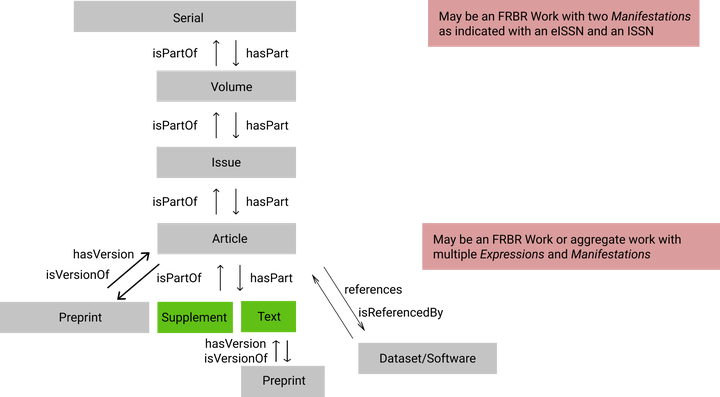
Abstract
Successful language archives provide meaningful links between their holdings and existing scholarly resources elsewhere including language-documentation evidence, language-descriptions, and language-development materials. The Open Language Archiving Community aggregator is one community-based approach to solving the related-resources and resource-discovery challenge. Language descriptions come in many forms, including journal articles, which are published in serials. Serials are increasing in their relevance to the audiences of language archives because many language archive collections have collection descriptions which are now being published as peer-reviewed articles (Sullivant 2020; Fitzgerald 2021). This leads to interesting questions about how collection descriptions and journal articles ought to be indexed in OLAC which follows Dublin Core conventions (Bird & Simons 2003). Currently, at least four OLAC data providers submit records for journal articles, with many more data providers mentioning articles in the description fields of artifact records. Each of these data providers has a unique way of using the OLAC application profile to provide metadata about articles. This creates an inconsistent user experience in a metadata-driven website such as OLAC. We present a template for describing journals and their content, based on well established Dublin Core conventions in the field of library science (Jones W. 2001; Cole 2002; Riva 2004; Shadle 2006; Allinson 2008; Jones E. 2018). The template is designed for OLAC data contributors as they index journal- and serial-typed artifacts within their holdings. We propose that journals are analogous to collections, and that articles are analogous to items in the well-known collection/item framework used by archives (Wickett 2012). The template is inclusive of best-practice library modeling applying insights from Functional Requirements of Bibliographic Records (FRBR) to OLAC records. FRBR is helpful when considering relationships between pre-prints, off-prints, and versions of record, i.e., publisher versions (Tillett 2001, 2005; Žumer et al 2010).
Bibliography
- Žumer, Zeng & Salaba (2010)
- Žumer, M., Zeng, M. & Salaba, A. (2010). FRBR: A Generalized Approach to Dublin Core Application Profiles. Dublin Core Metadata Initiative. Retrieved from https://dcpapers.dublincore.org/pubs/article/view/1024
- Riva, Le Bœuf & Žumer (2017)
- Riva, P., Le Bœuf, P. & Žumer, M. (2017). IFLA Library Reference Model A Conceptual Model for Bibliographic Information (December 2017). International Federation of Library Associations and Institutions (IFLA). Retrieved from https://www.ifla.org/publications/node/11412
- Riva (2004)
- Riva, P. (2004). Defining the Boundaries: FRBR, AACR and the Serial. The Serials Librarian, 45(3). 15–21. https://doi.org/10.1300/J123v45n03_02
- Tillett (2001)
- Tillett, B. (2001). Bibliographic Relationships. In Bean, C. & Green, R. (Eds.), Relationships in the Organization of Knowledge. (pp. 19–35). Springer Netherlands. Retrieved from http://link.springer.com/10.1007/978-94-015-9696-1_2
- Sullivant (2020)
- Sullivant, R. (2020). Archival description for language documentation collections. Language Documentation & Conservation, 14. 520–578. Retrieved from http://hdl.handle.net/10125/24949
- Fitzgerald (2021)
- Fitzgerald, C. (2021). A framework for Language Revitalization and Documentation. Language, 97(1). e1–e11. Retrieved from https://muse.jhu.edu/article/785544
- Bird & Simons (2003)
- Bird, S. & Simons, G. (2003). Extending Dublin Core Metadata to Support the Description and Discovery of Language Resources. Computers and the Humanities, 37(4). 375–388. https://doi.org/10.1023/A:1025720518994
- Allinson (2008)
- Allinson, J. (2008). Describing Scholarly Works with Dublin Core: A Functional Approach. Library Trends, 57(2). 221–243. https://doi.org/10.1353/lib.0.0034
- Cole (2002)
- Cole, T. (2002). Qualified Dublin Core metadata for online journal articles. OCLC Systems & Services: International digital library perspectives, 18(2). 79–87. https://doi.org/10.1108/10650750210430141
- Tillett (2005)
- Tillett, B. (2005). What is FRBR? A conceptual model for the bibliographic universe. The Australian Library Journal, 54(1). 24–30. https://doi.org/10.1080/00049670.2005.10721710
- Wickett (2012)
- Wickett, K. (2012). Collection/item metadata relationships (text). University of Illinois at Urbana-Champaign, Retrieved from https://www.ideals.illinois.edu/handle/2142/42198
- Jones (2018)
- Jones, E. (2018). The Evolution of the Serial Work, the FRBR Conceptual Model, and RDA. Cataloging & Classification Quarterly, 56(2-3). 128–145. https://doi.org/10.1080/01639374.2017.1388325
- Shadle (2006)
- Shadle, S. (2006). FRBR and Serials: An Overview and Analysis. The Serials Librarian, 50(1-2). 83–103. https://doi.org/10.1300/J123v50n01_09
- (N.A.) (1942)
- (N.A.).(1942). Retrieved from http://www.language-archives.org/item/oai:anla.uaf.edu:KO936S1942
- Higgins (2017)
- Higgins, C.(2017, 3/4). Retrieved from http://www.language-archives.org/item/oai:scholarspace.manoa.hawaii.edu:10125/41999
- Benjamin & Noone (1936)
- Benjamin, G. & Noone, H.(1936). Retrieved from http://www.language-archives.org/item/oai:humlab.lu.se:hdl:10050/00-0000-0000-0004-1513-4
- King (2005)
- King, P.(2005). Retrieved from http://www.language-archives.org/item/oai:sil.org:40239
- Ferreira & Rodríguez (n.d.)
- Ferreira, V. & Rodríguez, R. (s.d.). Retrieved from http://www.language-archives.org/item/oai:www.mpi.nl:tla_1839_00_0000_0000_0016_4F8F_E
- Brockett (1985)
- Brockett, A.(1985). Retrieved from http://www.language-archives.org/item/oai:rosettaproject.org:rosettaproject_acx_contents-1
Categories:
Content Mediums: